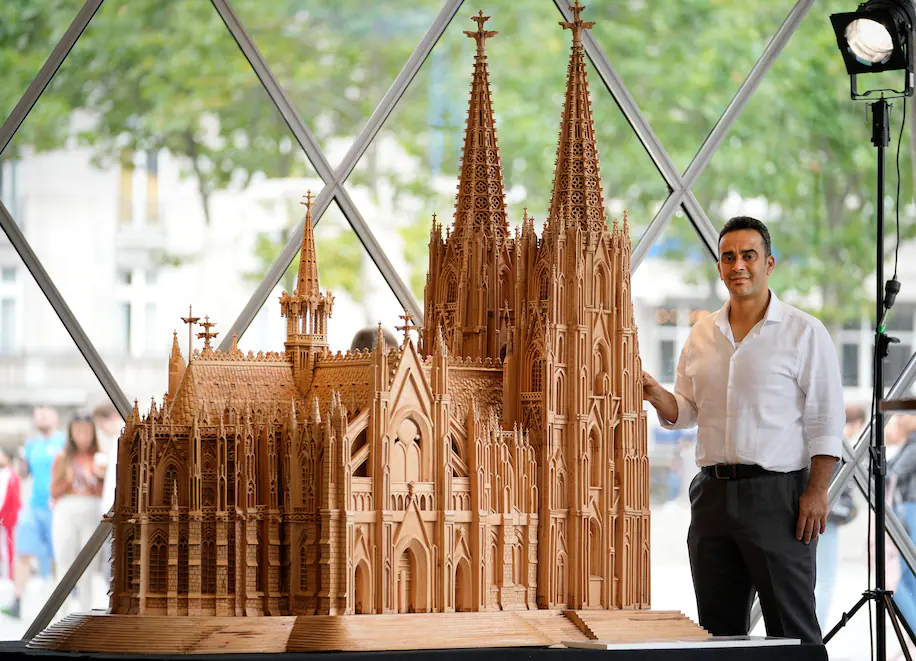
An AP story that ran recently in the Washington Post touched us deeply.
We shared the story with our Tysons Interfaith colleagues who also found the story to be very uplifting. We share it again here for all to appreciate:
WASHINGTON POST, June 27, 2022
www.washingtonpost.com/kidspost/2022/06/25/
Syrian refugee spends 5,000 hours carving model of German cathedral
Fadel Alkhudr, a woodcarver who fled war in Syria, was charmed by the cathedral in Cologne, his new home.
Fadel Alkhudr from Syria poses Monday with his wooden model of the Cologne Cathedral on display in Cologne, Germany. Alkhudr, a woodcarver from Aleppo, Syria, fled the war in his home country and arrived in Cologne in 2015. He became fascinated by the cathedral and decided to carve a model. (Martin Meissner/AP) Fadel Alkhudr from Syria poses Monday with his wooden model of the Cologne Cathedral on display in Cologne, Germany. Alkhudr, a woodcarver from Aleppo, Syria, fled the war in his home country and arrived in Cologne in 2015. He became fascinated by the cathedral and decided to carve a model. (Martin Meissner/AP)
When Syrian refugee Fadel Alkhudr arrived in Germany in 2015, the first thing he saw when he stepped out of the train in Cologne was the city’s majestic cathedral.
Alkhudr, 42, became so fascinated by the famous landmark on the Rhine River with its twin spires and elaborate ornaments that he spent hours looking at it. He took photos of it, drew sketches and eventually started carving a wooden model.
For more than 2½ years — or about 5,000 hours, he says — Alkhudr worked on creating a 6½-foot-tall copy of the structure in a small basement that he uses as a workshop in the city.
Alkhudr, who is Muslim, said he developed such a close connection to the Catholic cathedral that at some point it felt like the building became a part of him, “like it’s a dear friend to me.”
The Syrian, who learned carving from his father at the age of 13, first fled to Turkey and then to the western German city of Cologne after his family’s woodcarving business in Aleppo was destroyed during the war in Syria. He said he’s often asked if it didn’t feel strange for a Muslim to dedicate himself to Germany’s most famous Christian house of worship.
Not at all, he says, because growing up in Aleppo before the civil war, he had Muslim and Christian friends, and customers from different religions who came to buy wooden art at the family store.
“When we were in Aleppo we used to have … no issues between a mosque and a church,” the father of five recounts. “Our neighbors were Christian and we are Muslims. We used to invite each other into our homes and there were no problems.”
Alkhudr is one of more than 1 million migrants who came to Germany from Syria, Iraq and Afghanistan in 2015-2016, escaping war, destruction and poverty in their home countries. He first worked odd jobs to make a living, brought his family over in 2017, and, since 2019, focused on creating the cathedral model. He hopes that in the future he can also make a living in Germany as an art carver.
Alkhudr used hard beech wood and 50-year-old tools from Syria that his father had passed on to him. The end result was 6½ feet in height and length, and about 4½ feet in width.
The original cathedral is 500 feet tall and took more than 600 years — from 1248 to 1880 — to complete. It’s a United Nations World Heritage Site and hosts the Shrine of the Three Kings, believed to contain the bones of the “Three Wise Men.” The cathedral is one of Germany’s top tourist attractions and one of the oldest and most important pilgrimage sites of Northern Europe.
Alkhudr’s delicately chiseled work is on exhibit at the cathedral’s Domforum visitor center just across from the original. The Syrian hopes that he can present his woodwork in other cities, too, and thus spread what he sees as the cathedral’s unifying message.
“For me, the cathedral is a home for all people,” he said.
This blog post is the expressed opinion of its writers and does not necessarily reflect the views of Tysons Interfaith or its members.
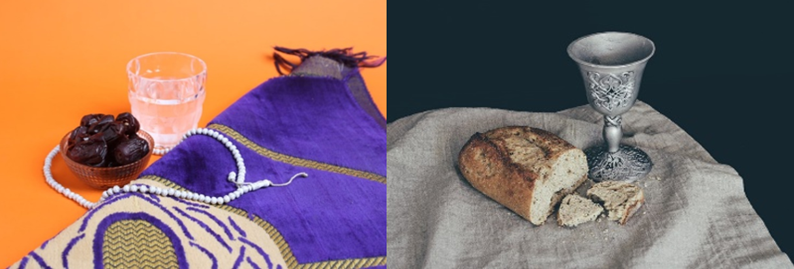
The following log is being presented in a series of weekly installments. To read this document in its entirety, please visit philchurch.substack.com
DAY 8 (FRIDAY, APRIL 8) – Phil is becoming expendable. HM arrived at our home a week earlier with clothes freshly washed and cleaned at a laundromat close to his hotel. He now needs to wash his clothes again. Connie shows him how to use our washing machine, how much soap to put in and what settings to use. HM now knows something about how to run our house that Phil doesn’t know. Phil is beginning to feel a bit expendable.
DAY 9 (SATURDAY, APRIL 9) – A helping hand from church members. Phil and Connie send out a request to our church fellowship group for a chest of drawers that HM might use in his bedroom. Within less than an hour after our request “hit the streets” we have a call with the offer of a 3-drawer chest. It’s now installed in his bedroom. He can take it with him – along with our daughter’s unwanted student desk – when he finds his own place to live.
DAY 10 (SUNDAY, APRIL 10) – Another Afghan friend, HA, comes to visit. We learn that HA arrived in the first wave of evacuees with his parents and a brother and was housed at Fort Bliss. It has taken HA nearly six months since his arrival to get all his immigration paperwork processed and only recently has been able to find a job as a data analyst with an area company. He brings, of course, food from his family’s Iftar dinner the night before. More delicacies again to please our pallets at dinner.
DAY 11 (MONDAY, APRIL 11) – We celebrate today. HM has a job offer. Not much of one, because it’s a short free-lance contract arranged through an Internet-based company – www.upwork.com – that matches computer techies with small-company clients that don’t need or can’t afford full time IT staff. In HM’s case the work would be constructing a website for the owner of a new restaurant. UpWork has an international talent base and matches employers and workers in a range of business and engineering areas around the world. It just may be of interest to other arriving refugees.
DAY 12 (TUESDAY, APRIL 12) – HM takes over our kitchen. It’s another day of AARP volunteer tax advising for Connie so she will be home late in the afternoon. (Only a few days remain till the tax filing deadline.) Phil normally “cooks” these evenings, that is he goes to get Chinese or Thai take out. When he suggests this option to HM, however, he gets pushback. There is still plenty of Iftar meal ingredients provided by his Afghan friends on hand so he suggests that instead. Phil has no counteroffer so HM takes over the kitchen and has a full meal ready when Connie walks in the door. She is delighted. Phil can’t complain. We three break (HM’s) Ramadan fast together. Phil even has trouble carrying out his normal kitchen duty – rinsing plates and putting them in the dishwasher. HM insists he must also do that. (Has HM’s mother back in Kabul encouraged him to be so helpful?) Whatever, Phil is really beginning to like HM. Connie already.
DAY 13 (WEDNESDAY, APRIL 13) – Another family relative emerges. After Iftar dinner together Phil shows HM an Opinion Page article from the day’s Washington Post about the need for the western countries to press the Afghan Taliban government on its promises to keep secondary schools open for girls. The article is written by Roya Rahmani, the former Afghan ambassador to the US (2018-2021) who is now also a refugee in the US and currently is a visiting fellow at Georgetown University’s Institute for Women, Peace and Security. HM declares Rahmani is a relative on his mother’s side. He knows her personally. Another layer of HM’s family-and-friends background emerges.
DAY 14 (THURSDAY, APRIL 14) – More variety in our daily meals. Today Phil and Connie schedule our Iftar meal to follow our Maundy Thursday evening church service. HM chows down as soon as we return home with food that still another friend, HK, has brought to share with him – rice, of course, along with chicken biryani and Qabuli palau, a tomato-based vegetable dish.
This blog post is the expressed opinion of its writer and does not necessarily reflect the views of Tysons Interfaith or its members.

The following log is being presented in a series of weekly installments. To read this document in its entirety, please visit philchurch.substack.com
We have been “observing” both Christian Easter Season and Muslim Ramadan this year. The choice was ours but then maybe, as part of some divine equation, it was not. Whatever, it has been a rewarding and fulfilling experience, one worth sharing. Notice that we put “observing” in quotes, because the month-long sun-up-to-sun-down fasting part of Ramadan is a bit more than we can handle. (Certain exemptions from fasting exist, of course, for the pregnant, elderly and the infirm among others.)
Our Ramadan observations began on Friday afternoon, April 1. That day Phil responded to a knock on the door, opened and welcomed HM into our home. Twenty-seven-year-old HM is part of the second wave of Afghan evacuees to arrive in America since August 2021. He left Kabul, Afghanistan in January 2022 for Islamabad, Pakistan where the US Embassy arranged for him to fly to a US military base outside Doha, Qatar. There, he underwent background checks, physical exams and vaccinations, and processing of his special immigrant visa (SIV) application.
In mid-March HM boarded a Qatar Airlines flight to Dulles International where he was met by his US sponsoring organization, Catholic Charities of the Diocese of Arlington which arranged short-term lodging for him and for some other Afghan evacuees at an Arlington hotel. When his US government-funded lodging allowance was exhausted, HM was expected to find other living arrangements that he could afford – not an easy task in Northern Virginia, one of the region’s most expensive and competitive housing markets.
HM is now our houseguest. We’re getting to know this interesting and intelligent young man, supporting his efforts to resettle in America, learning about the troubling challenges facing his parents and siblings still living in Kabul, Afghanistan, and meeting some of his friends from the growing Afghan diaspora here in Northern Virginia. The following is a daily log of events surrounding HM’s stay with us during the month of Ramadan.
[Note: As a precaution against possible repercussions by the Taliban government against family members remaining in Afghanistan, US State Department protocols urge that, until safe to do so, communications, particularly electronic media use initials in place of full names of Afghan refugees resettling in the US.]
WEEK 1 – GETTING ACQUAINTED
DAY 0 (THURSDAY, MARCH 31) – A phone call. It’s Thursday afternoon when Phil’s cell phone rings. On the other end is NF, a former Afghan employee of the US Embassy in Kabul with whom Phil is working on his job search. NF is resettling in America with his wife and three daughters. They arrived in the US as evacuees in September and settled into housing in Pittsburgh, PA. Phil hasn’t talked with NF for a few weeks, not since NF started working.
NF is calling with a request. A former work colleague in Kabul, HM, arrived in Virginia three weeks earlier. HM has now exhausted his two-week lodging allowance but has not yet found a place to live on his own or with friends. He does not yet have documents needed to work or to rent an apartment here. NF asks if can Phil talk to HM and see if there is anything he could do to help him find a place where he can afford to live. Phil agrees to talk to HM.
Within an hour HM calls Phil. He explains he can’t afford the hotel’s nightly room charge that his resettlement agency had been paying up to that time. His Afghan friends in the area have large families in small apartments; they just can’t take him in. HM is open to whatever Phil can suggest as to a cheaper place he might stay while he gets his papers in order and conducts his job search. He needs to check out of his hotel by noon the next day, Friday, also the day before the month-long Muslim Ramadan begins. Phil and HM exchange email addresses. Phil asks HM to send his resume.
Off the phone with HM, Phil calls the Catholic Charities office to inquire about HM’s refugee status but no one answers and all voice mail boxes are full, an indicator most likely of just how overwhelmed are the nine nonprofit agencies contracted nation-wide by the US government to resettle arriving Afghan refugees. Phil emails the organization but is not hopeful for an immediate reply. He has the evening to ponder the situation; he calls to consult Connie who is at our daughter’s townhouse for some mother/daughter time together. Phil and Connie concur that, absent any other viable options, HM could stay with us for awhile.
DAY 1 (FRIDAY, APRIL 1) – HM arrives. Phil’s morning is hectic. He reaches out again to Catholic Charities and is now able to leave a voice message and email address. By late morning he does get a proforma email message back that it is the organization’s policy not to release to third parties any information about its clients. Dead end, but understandable. Phil calls HM’s cell to see if he has been able to make any alternative living arrangements. None. Phil looks over HM’s resume. It indicates a college degree in computer sciences with lots of IT certifications and work experience with USG contractors in Kabul. The resume is well-written, reflective of the very good English with which HM communicates over the phone.
Phil invites HM to stay at our house in one of our empty-nester bedrooms. He offers to come to the hotel to get HM and his things. HM accepts the offer to stay with Phil and Connie but indicates that one of his Afghan friends will bring him to our home.
HM arrives with his Afghan friend, JN, who came to the US two years earlier and is living in Alexandria in a small apartment with his wife and six school-age children. Phil invites both HM and JN in and they settle into the sunroom for some tea and cookies and a brief chat. Phil senses that he is being sized up by both HM and JN who likely are a bit uncomfortable imposing on a Christian household, on such short notice for an indeterminate period of time. Phil must have passed the test, because after an hour, JN indicates he must get back to work and they will get HM’s suitcase and gear from his car.
Phil shows HM the bedroom that he has quickly arranged to accommodate him. Phil suggests HM freshen up and then they go out and get some lunch together and talk. Phil takes HM to his favorite take-out ‘gourmet’ restaurant, POPEYE’S! Phil, thinking ahead buys a few extra pieces of chicken realizing Connie could return home from our daughter’s might be hungry enough to excuse his wandering off onto the no-fast-food path.
That evening Connie prepares a shrimp appetizer – HM, growing up in a landlocked country – has not experienced very much seafood – and meat balls and spaghetti for dinner. HM is hungry but not very enthused about the shrimp or the meatballs. Not spicy enough we will learn later. The rest of the evening we talk and plan for the next day. HM expresses concerns over his Ramadan fasting commitment and how that might impact our daily routine. Phil and Connie tell HM that we’ve lived and worked in Muslim countries – Bangladesh and Pakistan – and are familiar with Islamic practices. HM appears relieved at hearing that.
DAY 2 (SATURDAY, APRIL 2) – Ramadan begins. Phil works with HM today on his job resume. Though HM’s written English is very good, his five-page resume needs some rewording to bring it down to just two pages of more focused information and to highlight his accomplishments better. HM works on revisions over a good share of the rest of the day. He is now fasting (since sun-up) and will not eat or drink till after sunset about 7:15pm. Connie wonders what to fix for dinner. In the middle of that quandary the doorbell rings and it is another of HM’s friends who has come to drop off Iftar (dinner) food for the three of us. Later HM explains the Muslim tradition of sharing Iftar food with others during Ramadan. We graciously accept the rice biryani, cut up chicken, and spicy okra vegetable dish. We eat well that evening. HM observes Phil’s and Connie’s practice of preceding dinner asking God’s blessing; we observe as, is HM’s practice, that he follows dinner with his thanks, “Praise Allah (God) who has fed us!”
DAY 3 (SUNDAY, APRIL 3) – HM’s family in Kabul. Connie and Phil had hoped to take HM to church service with them this morning. The night before, he had responded positively to our invitation and expressed interest in the experience. But when we tapped on his door in the morning we were greeted with a very drawn and exhausted HM who appeared to have had a sleepless night. We worried about that one shrimp or the meatballs, but later we would learn that he had been on his computer using WhatsApp to communicate with his family – Kabul time is nine hours ahead of ours – and HM admits he is a bit stressed and unsettled. Maybe next Sunday ….
Later in the day, HM explains that when he left Afghanistan, he left his mother and father, a sister and a brother still in Kabul. HM’s father works in a government statistics and census office. Under the Taliban government he is still expected to report to his ministry job daily but there is neither work to do or nor money to pay him. He tried to resign, HM reports, but the government refused his request. His father feared that if his father just stopped showing up for work there might be unfavorable repercussions for his family.
When we return from church, we find HM sitting in our living room with HS, yet another Afghan refugee friend. HS, we learn, is a trained dentist who came out of Afghanistan in early September with his family of 11 including wife, kids, parents and grandparents. He has been resettled nearby in Woodbridge. HS needs to pass the Virginia state dental board exams before he can continue his practice in Virginia. That will require at least a year of so more to prepare. Until then he is only able to work as a much lower-paid dental assistant.
There is one happy note: HM has been using HS’s home as his mailing address to receive letter mail related to his refugee status. HM’s social security card arrived in the mail and HS brought it to him today. HM is one important step closer to qualifying for employment.
DAY 4 (MONDAY, APRIL 4) – Halal food shopping. Connie and HM go food shopping at a Halalco supermarket in a nearby area where many middle eastern as well as Hispanic immigrants have settled. Their objective is to pick up some food items HM thinks Connie and Phil would enjoy eating. The items they bring home include 1×3 foot flat bread, very hot chili spices, specially seasoned ground beef, basmati rice and Tunisian dates. (Note: See photo image. Breaking fast with water and grapes is an Islamic practice that dates back 14 centuries to the life of the Muslim prophet, Mohamud.) HM sets about preparing Halal dinner with Connie helping. It’s a unique and delicious meal we have for dinner. HM has very developed cooking skills far exceeding Phil’s, for sure.
DAY 5 (TUESDAY, APRIL 5) – Opening a bank account. Today, one of HM’s friends comes by to take him to set up a bank account, now that he has a SSN. While Connie is out of the house doing volunteer AARP tax advising and HM is getting his bank account set up, Phil is left alone. He takes advantage of the moment to ‘break fasting’ and sneak a couple of pieces of leftover POPEYE’S chicken from the fridge.
DAY 6 (WEDNESDAY, APRIL 6) – Computer Geek as well as Gourmet cook. The router signal is very weak in the back bedroom where HM sleeps and works so he sets up his laptop at the kitchen table. Not good for his privacy and concentration when working. Our home wireless router needs a booster, he tells Phil. Can HM install a booster? asks Phil. Sure, says HM. Off to Best Buy they go and in less than a half hour after they return, HM has the booster installed and paired to our router with a strong enough wireless signal to return to working in his bedroom. HM is now hard into looking exploring job websites and talking via WhatsApp with his family in Kabul, often till the early hours of the morning.
DAY 7 (THURSDAY, APRIL 7) – A Ramadan fasting secret: cut the day in half by sleeping late. HM wakes up and appears downstairs about 2:00pm today to chat, no food, of course. He was up a good share of the night working till about 4:00am sending off job resumes and filling out job applications. Phil and Connie discover that during Ramadan, HM will spend his late evenings and early mornings on ZOOM working on his job search and talking with his family in Kabul while snacking, so he is plenty full with only a short half day to fast when he wakes up around noon. A young Muslim man’s clever way of accommodating lifestyle and religious practice.
This blog post is the expressed opinion of its writer and does not necessarily reflect the views of Tysons Interfaith or its members.
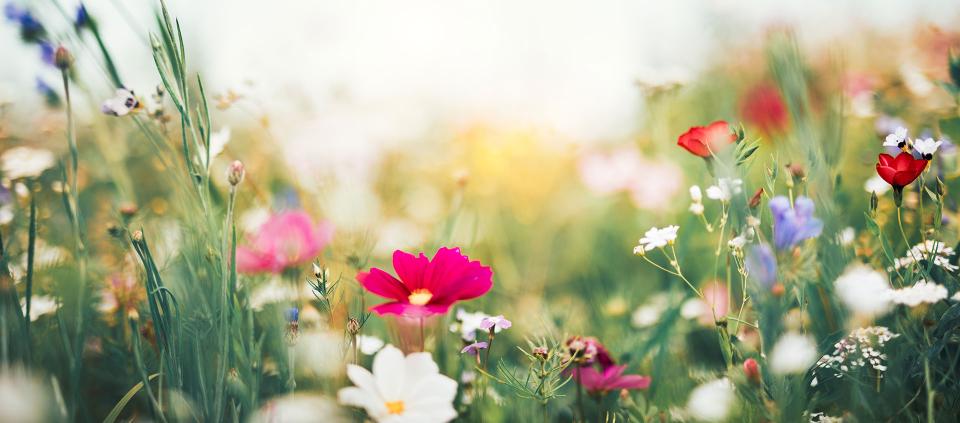
On Sunday, May 8, we celebrated Mother’s Day. On that day, I was struck by what Heather Cox Richardson, an American history professor at Boston College, had to say about the history of the observation in her May 7 Letters from an American post heathercoxrichardson.substack.com/p/may-7-2022:
“If you google the history of Mother’s Day, the internet will tell you that Mother’s Day began in 1908 when Anna Jarvis decided to honor her mother. But “Mothers’ Day”—with the apostrophe not in the singular spot, but in the plural—actually started in the 1870s, when the sheer enormity of the death caused by the Civil War and the Franco-Prussian War convinced American women that women must take control of politics from the men who had permitted such carnage. Mothers’ Day was not designed to encourage people to be nice to their mothers. It was part of women’s effort to gain power to change modern society.”
Richardson went on to say that it was Julia Ward Howe, the author of the Battle Hymn of the Republic, who originally authored an Appeal to Women throughout the world to establish a “’festival which should be observed as mothers’ day, and which should be devoted to the advocacy of peace doctrines’ to be held around the world on June 2 of every year, a date that would permit open-air meetings.”
“For Howe, the Civil War had been traumatic, but that it led to emancipation might justify its terrible bloodshed. The outbreak of the Franco-Prussian War in 1870 was another story. She remembered:
“’I was visited by a sudden feeling of the cruel and unnecessary character of the contest. It seemed to me a return to barbarism, the issue having been one which might easily have been settled without bloodshed. The question forced itself upon me, “Why do not the mothers of mankind interfere in these matters, to prevent the waste of that human life of which they alone know and bear the cost?”’
Abdu’l -Baha, the leader of the Baha’i Faith from 1892-1921 wrote: “Equality between men and women is conducive to the abolition of warfare for the reason that women will never be willing to sanction it. Mothers will not give their sons as sacrifices upon the battlefield after twenty years of anxiety and loving devotion in rearing them from infancy, no matter what cause they are called upon to defend. There is no doubt that when women obtain equality of rights, war will entirely cease among mankind.”
With wars still raging in our world, it seems very relevant for us to understand that the original “Mothers’ Day” movement was an appeal to women to bond together to demand an end to bloodshed. Empowering the women in our lives, honoring their voices and seeking paths to world peace indeed seems to me to be the best way to honor our mothers.
This blog post is the expressed opinion of its writer and does not necessarily reflect the views of Tysons Interfaith or its members.
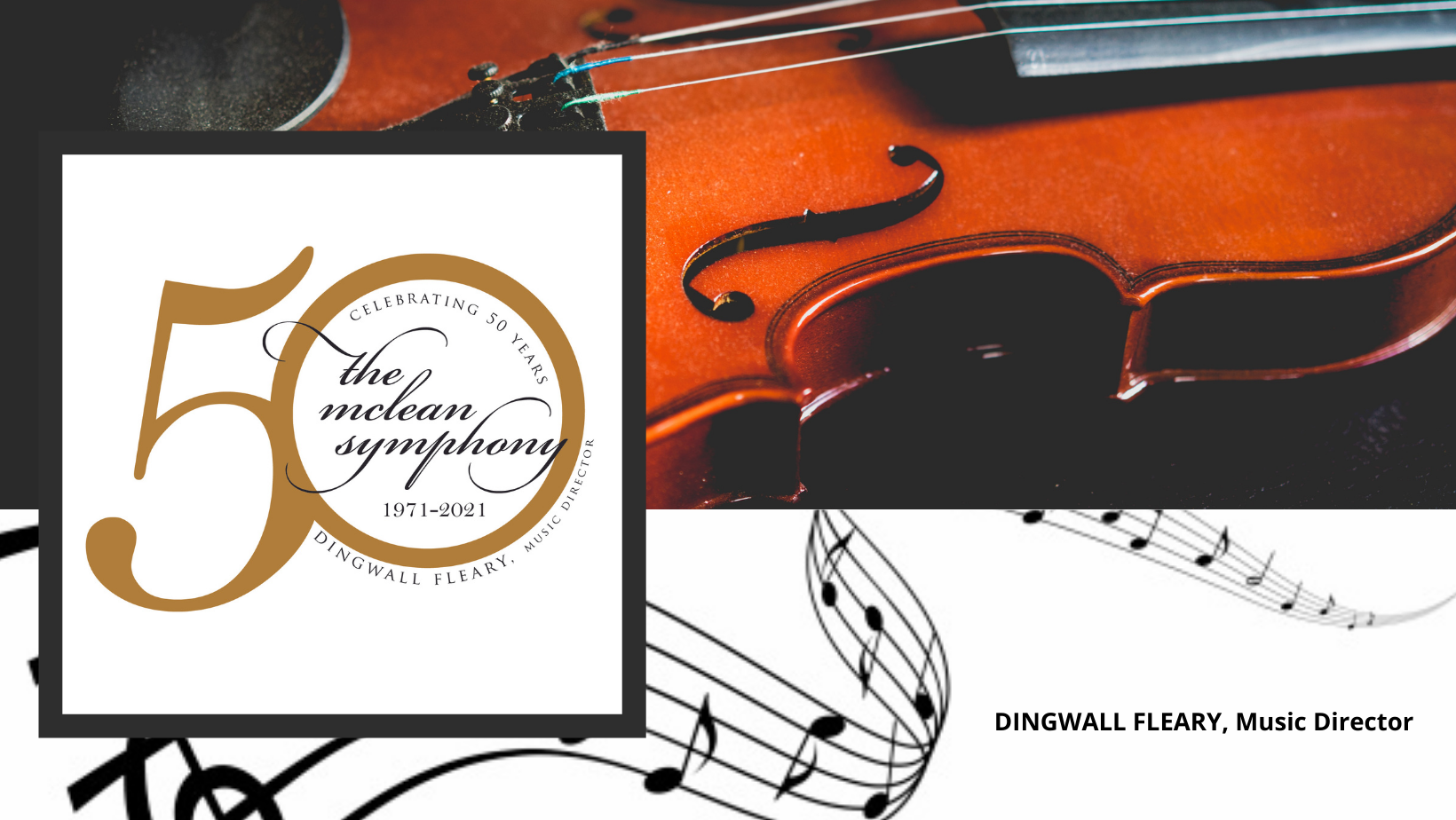
The McLean Symphony is a musical gem, right here in Tysons! It is an all-volunteer orchestra, composed of musicians living primarily in Fairfax County – our own friends and neighbors. It is the only symphony in the immediate Tysons area, and this is a very special year for them.
During the summer of 1970, directors of McLean’s Academy of Musical Arts asked young local conductor Dingwall Fleary to organize an amateur, grass-roots orchestra in the McLean Community. The primary purpose was to provide talented, non-professional instrumentalists an opportunity to perform publicly as an ensemble or orchestra. Among the earliest and most enthusiastic supporters were Washington Post editor and McLean resident Robert Ames Alden, his wife Diane, news correspondent Roger Mudd, and his wife “E.J.”
The McLean Chamber Orchestra, as it was known in 1971, has grown from the original 18 musicians to nearly 60 players. The orchestra’s expansion has led to broader and more diverse symphonic repertoire and an opportunity to feature up-and-coming, as well as established solo artists primarily based in the metropolitan Washington area. In addition to local concerts, the orchestra has been invited to play at the Wolf Trap Farm Park, the Kennedy Center, and Strathmore Hall. Over the years, under the continued leadership and guidance of its founding director, the group has developed into an impressive aggregation that proudly bears the name, The McLean Symphony!
The McLean Symphony will be performing a 50th Anniversary celebratory concert on Saturday evening, April 9th at Capital One Hall. Nicole Lacroix, host of WETA Classical, will host this special event, featuring music of American composers. The program will include the Third Symphony, in C Minor, by Florence Price; the Second Piano Concerto, in D Minor, by Edward MacDowell, featuring extraordinary virtuoso soloist, Carlos Ibay; and the premiere of Creatures of Darkness and Light, by Virginia-based composer, Nikita Wells. Anyone who enjoys live orchestral music is in for a treat if they attend this concert on April 9.
Though the McLean Symphony is a volunteer organization, they do incur expenses for music licenses, logistics, and guest performers. Those expenses are offset through ticket sales and by generous donors. Tickets for the April 9th concert may be purchased through Ticketmaster or through this link: The McLean Symphony 50th Anniversary Concert (capitalonehall.com). For the discounted pricing available to Tysons Interfaith members, friends, and those reading this blog, use code TMSFRIEND.
[When you call up or see the event on the Ticketmaster page, click “Unlock.” Enter TMSFRIEND. Click “unlock” to the right of the passcode. Verify the number of tickets you want to purchase and complete your transaction.]
This blog post is the expressed opinion of its writer and does not necessarily reflect the views of Tysons Interfaith or its members.
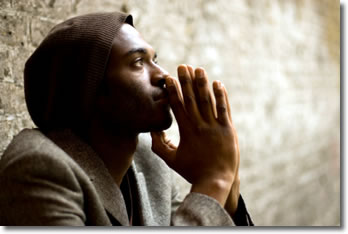
You are invited to “Pause for Peace” … to cause a “spiritual chain reaction!”
Just imagine if you invited everyone you know to invite everyone they know to “Pause for Peace” … just stop what they are doing for maybe 1 or 2 minutes (or more if they choose) and consciously choose to be peace. Their worlds will be transformed, and in the process, our whole world will experience a shift. Peace will prevail.
Our congregation at the Center for Spiritual Living Metro has chosen 12:00 noon each day plus any other time that the thought occurs, just “Pause for Peace.”
In addition, Tysons Interfaith invites you to immerse yourself for an hour in prayers and meditations for Peace from an array of traditions. This event will take place virtually on Sunday, April 3 beginning at 4:00 pm. To register, please visit: eventbrite.com
We hope you will join us as collectively we raise the consciousness of the world to Peace.
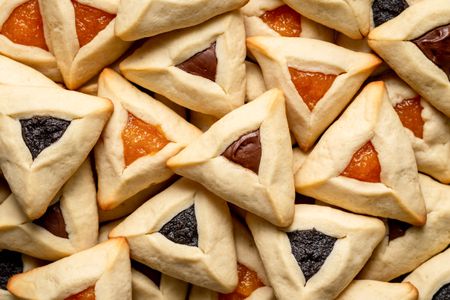
Next to Chanukah, Purim is probably the holiday to which Jewish children can most relate. There are costumes, carnivals and Hamentaschen (preserve filled cookies in the shape of a triangle). When the story is told, they get to make lots and lots of noise with groggers (twirling noise makers) in hand. But surely there is more to the holiday than that.
In the Hebrew bible, in Kethuvim (the Writings), appears the Book of Esther or Megillat Esther. In this short book, the story is related about a Persian king, who by historic timing might have been Xerxes I or Artaxerxes I. His first wife has the audacity to disobey him and she is banished. A call is put forth for a new wife and fair women from throughout the kingdom vie for this opportunity. Among them is Esther, a Jew. She wins the contest, but never reveals her background.
Concurrent with the wife plot is the plot of Haman who hates the Jews. Like generations before and after him, he couches his hatred by saying “There is a certain people, scattered and dispersed among the other peoples in all the provinces in your realm, whose laws are different from those of any other people and who do not obey the king’s laws; and it is not in Your Majesty’s interest to tolerate them”. (Esther 3:8).
Esther, from her position within, takes the risk of revealing her Jewishness to the king, and then exposes Haman’s plan to destroy her and her people. The king cancels Haman’s plans and Haman is executed.
Purim, like Chanukah, is traditionally viewed as a minor festival, but elevated to major holiday status as a result of the Jewish historical experience. Over the centuries, Haman became the embodiment of every antisemitic leader in every land where Jews were oppressed. The significance of Purim lies not so much in how it began, but in what it has become: a thankful and joyous affirmation of Jewish survival against all odds.
This blog post is the expressed opinion of its writer and does not necessarily reflect the views of Tysons Interfaith or its members.
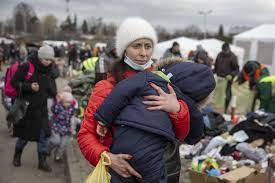
Looking for ways to help the Ukrainian people? The consensus is that cash donations made to organizations working on the ground is the best way to help.
This is by no means an exhaustive list, and Tysons Interfaith cannot endorse any particular group, but the following links may be of assistance as you consider your options:
- The US Agency for International Development (USAID) provides a list of organizations responding in Ukraine: https://www.cidi.org/disaster-responses/ukraine-crisis/
- This NPR piece highlights a few organizations providing assistance: https://www.npr.org/2022/02/25/1082992947/ukraine-support-help
- The US State Department has partnered with GoFundMe to raise funds to address the humanitarian needs of the people affected by the Russian aggression against Ukraine. All donations raised will be distributed to verified nonprofit organizations supporting vulnerable communities to obtain access to shelter, food, medical services, education, and psychosocial support, as well as other people impacted https://www.gofundme.com/f/ukraine-humanitarian-fund
- St Andrew Ukranian Orthodox Cathedral in DC is collecting medical supplies and other items through an Amazon wishlist that they are distributing to people on the ground in Ukraine. MOST IMPORTANT THINGS NEEDED: Medical Supply (bandaids, Neosporin, ibuprofen, etc). NO LIQUIDS, NO BATTERIES, NO CLOTHING, NO MILITARY COMBAT EQUIPMENT, NO DIAPERS. Order on amazon and/or deliver to: 15100 New Hampshire Ave. Silver Spring, MD 20905 Wishlist: https://www.amazon.com/hz/wishlist/ls/2ADMR0OG6MBVX?ref=cm_sw_sm_r_un_un_m4ZOH13VxHHyO
- World Central Kitchen, founded by Chef José Andrés, is responding: https://wck.org/
- Lutheran World Relief is working in Eastern Europe: https://donate.lwr.org/give/393187
- Episcopal Relief and Development has established a Ukraine Crisis Response, Fund, working with organizations on the ground in Europe: https://support.episcopalrelief.org/ukraineresponse

Finally, people of good will of different faith traditions are joining together to call for peace in the region. An example of this united voice can be found here: https://elca.org/News-and-Events/8131
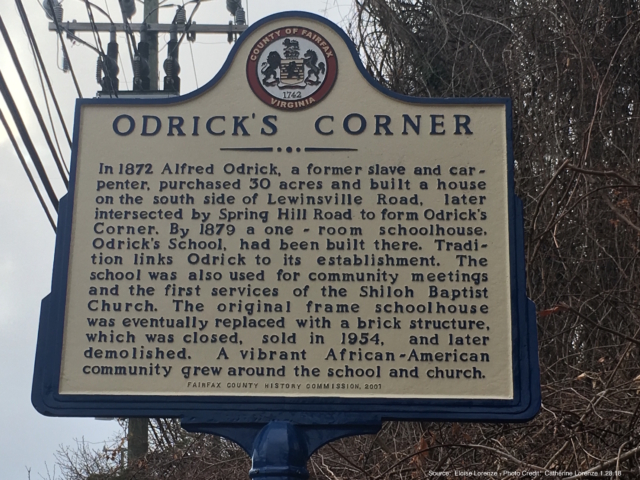
Its origins date back to 1925, but since 1976 every President of the United States has proclaimed February to be Black History Month in acknowledgment of the often-underappreciated contributions African Americans have made to our country. (Black History Month) The resources available to explore this rich history – on various online and streaming services, in libraries, and in schools — have never been better, but the need to explore and understand them is just as urgent.
As the Rev. Canon Leonard L. Hamlin, Sr., Canon Missioner and Minister of Equity and Inclusion at the Washington National Cathedral puts it:
“Yes, Black History Month is about the past, but it must also be about our present, as well as the future we hope to forge, together, as Americans.” He notes that one theme chosen for 2022, that of Black Health and Wellness, is “a way to celebrate all the ways African Americans have touched our bodies and souls, whether as essential workers, front-line health providers or in small ways to promote wellness.” And he urges us to consider the “racial and economic disparities of the COVID-19 pandemic” and to “follow the guidance of those who, throughout history, have challenged us to imagine something different, something better.” https://cathedral.org/press-room/black-history-month-is-about-so-much-more-than-our-history/
Many of those leaders have been inspired by their faith traditions, as should we.
Fairfax County has also prepared a number of opportunities for residents to get involved in Black History Month, focusing on collecting stories from current and former residents and providing resources to students to engage in project-based learning activities and the county’s historical marker program.
The Fairfax County Black History Month Program will be streamed live on Friday, February 11th from 7pm-8pm on Channel 16.
The link to the live stream is: https://www.fairfaxcounty.gov/cableconsumer/channel-16/stream.
This year’s theme is:
The Black/African American Experience Project. This is a joint effort among Fairfax County’s Board of Supervisors, Fairfax County Public Schools (FCPS), History Commission, and Neighborhood and Community Services. There are three parts of this effort: collecting stories, project-based learning, and historical markers.
The Historical Marker Project: will initially focus on the Black/African American experience and all students from K-12 (public, private, homeschooled etc.), classrooms and community youth groups can submit ideas for new Historical Markers throughout Fairfax County. The Historical Markers can commemorate an event, person, or location of historical significance within the county. Submissions are being accepted from February 1, 2022, through March 31, 2022. Students can learn more about the project, submission guidelines, and access links to resources at www.fairfaxcounty.gov/topics/historical-marker-project.
Project- Based Learning: As part of project-based learning, FCPS will provide resources to support students in researching untold local stories of Black/African Americans and groups who have impacted our community. FCPS has also provided resources that have been published at https://www.fcps.edu/news/fcps-launches-historical-marker-project-highlight-untold-stories-countys-african-american for equitable access to students who are not enrolled in FCPS schools.
Collecting Stories: As part of the effort to increase the visibility of Black/African American experiences in the county, Neighborhood and Community Services is asking current and former county residents to share their stories. We are collecting stories about your family, community, church (faith community), cultural, educational, justice, innovation, or housing experiences. There are two ways that stories are being collected. You can complete the African American Experiences submission form on their website: www.fairfaxcounty.gov/topics/black-african-american-stories or you can share your oral history on video by making an appointment with their computer clubhouse technicians to have your stories recorded. Those interested can email collectingstories@fairfaxcounty.gov to set up an appointment. These stories will support the project-based learning at Fairfax County Public Schools, help build a racial history timeline and increase the visibility of Black/African American contributions to the county.
Finally, here is a link to discover twenty ways to celebrate and experience Black History Month in the DC Metro area:
https://www.fxva.com/blog/post/african-american-history/
This blog post is the expressed opinion of its writer and does not necessarily reflect the views of Tysons Interfaith or its members.
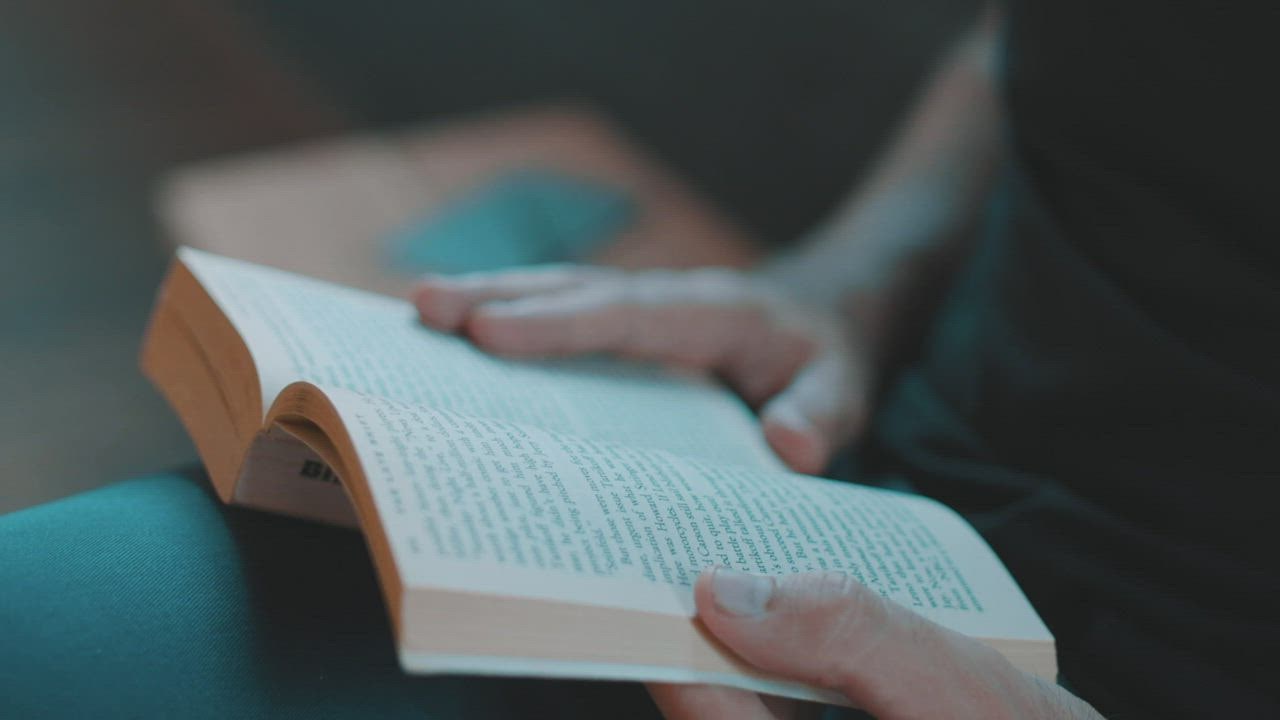
As we enter fall and winter months, have you been thinking about starting or joining a book club? Here are reflections from a book club at my church on books they read on an important topic and how they went about organizing their book club.
Over the past year, a group of Redeemer Lutheran members met to read and discuss books focusing on social justice. One member volunteered to set up the zoom meetings and then summarized the discussion in an email back to the group before the next meeting. The emails deepened their experience and helped them retain important parts of the books. They met weekly and discussed assigned chapters of the books and found this pattern allowed them to discuss the contents more thoroughly.
They are sharing their experiences with the congregation, first by providing a list of the books they read. They are also building a lending library they hope to offer soon.
Here is a list of the books they explored together, with a brief description:
Caste by Isabel Wilkerson: May have been the most influential book our group read in that it challenged us to think about how our entire social structure is an unrecognized caste system.
My Grandmother’s Hands: Racialized Trauma and the Pathway to Mending Our Hearts and Bodies by Resmaa Menakem: Written by a licensed clinical social worker who explores the complex effects of racism and white privilege on all races. Provided many exercises to work through our own reactions to racial trauma.
Devil in the Grove by Gilbert King: The winner of the 2013 Pulitzer Prize for General Nonfiction: A historical account of how Thurgood Marshall (before he became a Supreme Court Justice) and the NAACP brought civil rights cases to courts throughout the country. It highlighted the huge legal challenges that took place to correct injustices, how fragile some of those victories were, and how it could have all gone wrong.
His Truth is Marching On by Jon Meacham: A biography of John Lewis. We were moved by his unwavering bravery and commitment to civil rights, as well as his deep Christian faith.
Between the World and Me by Ta-Nehisi Coates: A moving account of how a young man felt about growing up Black in America, written in the form of a letter to his young son.
Dear Church, a love letter from a Black Preacher to the whitest Denomination in America (ELCA) by Lenny Duncan: A very challenging book which made us consider our own implicit racism and what our responsibility might be to address it in our church and in our neighborhoods.
The Vanishing Half by Brit Bennett: Our only novel. It introduced the subject of colorism and what sacrifices people make to integrate into the dominant society and what it costs to leave your family behind.
I am grateful to the members of my church for sharing their experience. I’ll be picking up a couple of these titles soon.
